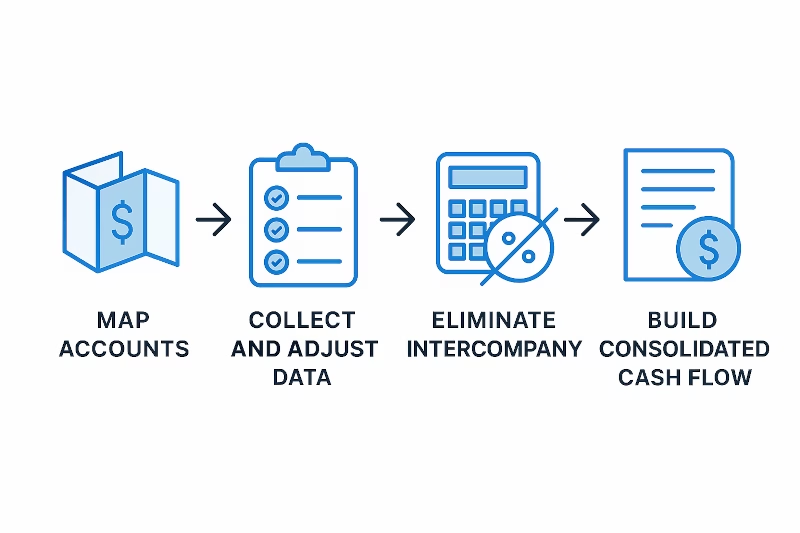Introduction
Cash is the lifeblood of any business—and for groups with multiple subsidiaries, knowing where cash comes from and where it goes is critical. A consolidated cash flow statement (CFS) provides this big-picture view across the entire group.
But building one isn’t as simple as stacking together each subsidiary’s statement. In fact, relying only on entity-level cash flows often creates inconsistencies, errors, and reconciliation nightmares. The best practice is to derive the group cash flow statement from consolidated balance sheet (BS) and profit & loss (P&L) first.
- In this guide, we’ll walk through:
- The step-by-step process of preparing a consolidated cash flow statement
- Why BS and P&L are the foundation for CFS
- The common challenges and how to solve them
- Best practices to improve speed, accuracy, and compliance

Step 1: Gather Subsidiary Financials
Most groups start by collecting balance sheet, P&L, and cash flow statements from each entity. But here’s the key: don’t assume the entity-level cash flows can simply be summed up. Instead, ensure the BS and P&L from each entity are aligned and standardized.
📌 Example: Subsidiary A may classify interest received as “operating activity” while Subsidiary B reports it under “investing activities.” If you aggregate cash flows directly, your consolidated report becomes inconsistent. By starting from BS and P&L, you can enforce one classification policy at the group level.
Step 2: Map Accounts and Counterparties
Create a mapping table that aligns subsidiary accounts with the group’s chart of accounts. This ensures consistency and comparability.
📌 Example Mapping
| Subsidiary Account | Group Account | Counterparty (if intercompany) |
|---|---|---|
| A: Intercompany Loan to B | Group: Loans Receivable | Subsidiary B |
| B: Intercompany Loan from A | Group: Loans Payable | Subsidiary A |
| C: Dividend Payable to Parent | Group: Dividends Payable | Parent Entity |
This mapping makes intercompany eliminations much easier later on.
Step 3: Convert to Reporting Currency
For multinational groups, convert all financials into the parent company’s reporting currency. Use:
- Average rates for P&L items
- Closing rates for balance sheet items
- Historical rates for equity movements
This step ensures consistency in consolidation and avoids mismatches in the cash flow statement.
Step 4: Eliminate Intercompany Transactions
This is where most errors creep in. Intercompany balances and transactions (e.g., loans, dividends, management fees, internal sales) must be eliminated.
📌 Example: If Subsidiary A pays $1M to Subsidiary B for services:
- A records an expense and cash outflow
- B records revenue and cash inflow
- At group level, this doesn’t represent external cash movement and must be eliminated
If not removed, the group’s consolidated cash flow will be overstated.
Step 5: Build the Consolidated Balance Sheet and P&L
Once eliminations are done, create the consolidated BS and P&L. These are the “primary” financial statements—the backbone of group reporting.
Now comes the critical part: derive the consolidated cash flow statement from the BS and P&L movements, not by summing up subsidiary-level cash flows.
Step 6: Why Consolidated Cash Flow Should Be Derived from BS and P&L
At this stage, many teams are tempted to consolidate the cash flow statements directly. But here’s why that’s risky:
- Consistency – Subsidiaries may use different methods (direct vs indirect) and classify items differently. Starting from BS & P&L ensures uniform treatment.
- Control & Transparency – The BS & P&L are the primary source documents. By deriving CFS from them, you guarantee traceability.
- Audit Trail – Auditors validate cash flow movements against BS and P&L changes. If your CFS doesn’t tie back, expect questions.
- Eliminations – Intercompany eliminations affect BS and P&L directly. If you don’t flow these through first, eliminations may be missed in cash flow.
📌 Illustrative Example:
- Consolidated P&L shows $50M net income
- Consolidated BS shows $5M increase in receivables
- Therefore, operating cash flow starts with $50M and adjusts down by $5M = $45M
If you had just aggregated entity-level cash flows, you might miss timing differences or elimination entries.
Key takeaway: Always prepare the consolidated CFS as a derivative of the BS & P&L, not as a sum of cash flow statements.
Step 7: Aggregate and Format the Consolidated CFS
Now, classify movements into:
- Operating Activities (net income, working capital changes, depreciation, etc.)
- Investing Activities (capex, acquisitions, disposals)
- Financing Activities (debt issuance/repayment, dividends, equity movements)
At this point, you have a properly reconciled consolidated cash flow statement.
Common Challenges in Preparing a Consolidated Cash Flow Statement
Preparing a consolidated cash flow statement (CFS) isn’t only about numbers—it’s about aligning processes, policies, and systems across multiple entities. Here are the most common challenges that finance teams encounter:
1. Inconsistent Reporting Methods
Some subsidiaries prepare their cash flow using the direct method (listing actual cash inflows/outflows), while others use the indirect method (starting from net income and adjusting for non-cash items). When these different approaches are aggregated, the group report lacks consistency.
Impact: It becomes impossible to compare performance across subsidiaries, and auditors may flag the consolidated statement for inconsistency.
2. Different Accounting Policies Across Entities
One entity may classify interest received as an operating activity, while another books it under investing activities. Similarly, dividends paid may be shown under financing in one entity, and operating in another.
Impact: Without standardized policies, the consolidated cash flow misrepresents the true cash position of the group.
3. Currency Translation and Exchange Rate Volatility
For multinational groups, subsidiaries operate in different currencies. Translating those cash flows into a single reporting currency (usually the parent’s) involves using closing rates, average rates, and sometimes historical rates for equity movements.
Impact: Misapplication of rates can distort movements, creating unexplained differences between the CFS and BS/P&L changes.
4. Intercompany Mismatches
Subsidiary A may record a payment to Subsidiary B in March, but B only records the receipt in April. This timing difference creates mismatched balances. Without proper reconciliation, eliminations may leave residual balances that inflate or understate consolidated cash flows.
Impact: Overstated inflows/outflows in group CFS, making liquidity planning inaccurate.
5. Manual, Time-Consuming Processes
Most finance teams still rely on Excel spreadsheets to gather subsidiary reports, adjust for eliminations, and build consolidated statements. As the group grows, so do the spreadsheets.
Impact: Manual processes increase the close cycle by days (sometimes weeks) and expose the CFS to human error.
6. Audit and Compliance Pressure
Auditors require a clear trail from consolidated BS and P&L to the cash flow statement. If the CFS doesn’t reconcile cleanly with the underlying financials, the finance team spends additional weeks preparing explanations and supporting schedules.
Impact: Delays in audit sign-off and frustration at both auditor and management level.
Best Practices for Reliable Consolidated Cash Flow Statements
To overcome these challenges, finance teams should move beyond manual workarounds and adopt structured, standardized practices.
1. Derive CFS from Consolidated BS and P&L
Instead of aggregating subsidiary-level CFS, always calculate the group CFS from changes in consolidated BS and P&L. This ensures that eliminations, FX adjustments, and group-level reclassifications are all captured automatically.
Benefit: Provides an audit-ready, traceable link between the three statements.
2. Standardize Accounting Policies and Classifications
Define a group-wide accounting policy that dictates where items belong (e.g., interest, dividends, lease payments). Train subsidiaries to follow this policy when submitting financials.
Benefit: Ensures comparability and prevents misclassification in the final consolidated report.
3. Automate Intercompany Eliminations
Set up rules in your consolidation system (or ERP) to auto-match and eliminate intercompany balances. For example, if Entity A books a loan to Entity B, the system should automatically offset the payable and receivable at consolidation.
Benefit: Reduces manual reconciliation, prevents overstated cash movements, and speeds up the close cycle.
4. Establish a Unified Chart of Accounts (CoA)
A standardized CoA across the group ensures that all entities map to the same reporting structure. Even if local GAAP requires variations, a clear mapping to the group CoA must exist.
Benefit: Simplifies consolidation, reduces errors in classification, and enables faster reporting.
5. Manage Currency Translation with Care
Use:
- Closing rates for balance sheet items
- Average rates for P&L
- Historical rates for equity transactions
Also, provide clear guidance on how FX differences will be treated in the cash flow (e.g., presenting them separately as “effect of exchange rate changes on cash and cash equivalents”).
Benefit: Eliminates confusion and provides a consistent approach auditors can follow.
6. Invest in Automation & Consolidation Tools
Instead of juggling dozens of Excel files, adopt tools like BrizoSystem to automate:
- Subsidiary submissions
- Mapping to group accounts
- Intercompany eliminations
- Cash flow derivation from BS/P&L
Benefit: Cuts reporting time from days to hours, reduces human error, and provides audit-ready reports.
7. Build a Robust Audit Trail
Document every step—mapping rules, elimination entries, FX rates applied. This not only supports the external audit but also strengthens internal control.
Benefit: Fewer audit queries and smoother year-end closing.
8. Continuous Validation During Close
Instead of waiting until the end, validate reconciliations as you go:
- Check that entity cash balances tie to bank statements
- Confirm that intercompany balances match across entities
- Validate FX translation impact before consolidation
Benefit: Prevents last-minute surprises and keeps the closing process on track.
Conclusion
A consolidated cash flow statement is more than a compliance document—it’s a vital tool for liquidity management and group strategy. The main pitfalls are inconsistent reporting, FX complexity, intercompany mismatches, and reliance on manual processes.
The solution lies in discipline and automation: standardizing policies, deriving cash flows from BS & P&L, automating eliminations, and building a strong audit trail. Finance teams that follow these practices not only close faster but also provide management with actionable insights into the group’s cash position.
With BrizoSystem, finance teams can automate consolidation, eliminations, and reporting—turning a stressful, manual task into a streamlined, reliable process.

